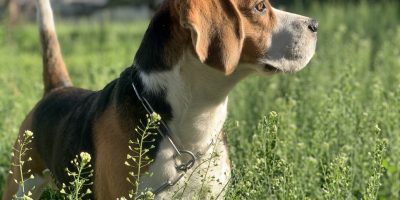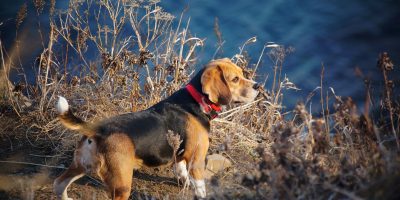A race described by its fanciers as “joyous,” Beagles are loving, lovely, happy, and friendly, all of which make them excellent family dogs. Not surprisingly, Beagle has been the most popular dog among American pet owners for years and owners can start training a Beagle to hunt if they want. These are curious, smart, and energetic hounds that need lots of time to play.

A Beagle’s Nose
A nose of a beagle is not just for show and you can do training a beagle to hunt. Although most dogs have approximately 220 million scent receptors compared to only about five million people, scent dogs have even more smell cells.
The Beagle’s small nose has a whopping 225 million receptors. Beagles were born to sniff, in other words. Your Beagle would spend too much time skimming the ground on his paws, that if he had a skid mark, you wouldn’t be surprised.
You can’t train a beagle or any dog not to sniff. This is how they discover what is happening in their world. However, on some occasions, you can teach your dog to smell less — say when you want to go for a walk. Get the attention of your dog with a treat. (Not surprisingly, especially smelly treatments work wonders.) Bring it up to your face at eye level and say its name, instead of giving your pup the treat. After a good eye and much praise, let him enjoy his reward. Eventually, looking up from time to time will be more a treat than sniffing an elusive fragrance.
Exercise
Beagles are active, powerful dogs who have to exercise for at least an hour every day. It’s not about setting them to play in the backyard. Beagles were raised in packs and are happiest when they’ve got a client. A Beagle that has been left alone for a long time inside or outside appears to be harmful.
This can be avoided if he has to play with a companion (human or canine). Beagles are escape artists, so a fence must be at least five meters high and extend beneath the ground to prevent tunneling. Walks must always be kept on a leash as a Beagle can not resist the urge to run off in search of a convincing smell like a scenthound with an excellent hunting instinct.
Training

Like any dog, early socialization and puppy training are a must. Treats are an enormous training aid. Beagles are not well trained for stringent methods, but in the end, it will prevail over endurance, constructive reinforcement, and even a touch of imagination.
A nose of a beagle is not just for show. Although the majority of dogs have approximately 220 million scent receptors compared to only about five million people, scent dogs have even more smell cells.
Beagles were born to sniff, in other words. Your Beagle would spend too much time skimming the ground on his paws, that if he had a skid mark, you wouldn’t be surprised.
You can’t train a beagle or any dog not to sniff. This is how they discover what is happening in their world. However, on some occasions, you can teach your dog to smell less — say when you want to go for a walk. Get the attention of your dog with a treat.
Bring it up to your face at eye level and say its name, instead of giving your pup the treat. After a good eye and much praise, let him enjoy his reward. Eventually, looking up from time to time will be more a treat than sniffing an elusive fragrance.
Many well-proven techniques are available to train a Beagle to kill rabbits. The most straightforward approach is to use and stick with it.
Start the most determined cup when it comes to preparing a beagle cup, as determination is the best attribute at a beagle and the most valuable training resource. As with most training, methods can change with different dogs and personalities from season to season.
Training A Beagle to Hunt

Usually, the best time to start training a beagle to hunt is when a puppy is between the ages of 5 and 8 months, but some trainers begin when the puppy is weaned. Most trainers believe that a dog will have some basic instruction on obedience before any animal starts to hunt. When it is uncontrollable on the ground, the work is overwhelming rather than fun.
If your pup is used to a training necklace, you can use a training necklace to keep him on track when he goes straight. The puppy just trains to know the rabbit’s scent if you start earlier than five months.
Using old skins of a rabbit or a rabbit foot that still smells, the puppy can recognize a rabbit’s fragrance early on. The real training is best done in the season, though, when you can hunt.
Quick Repeated Preparation
Rabbit hunting is best taught several days in a row, not over a long period, just like other hunting styles. While training a beagle to hunt, you must be mindful. When the rabbits are most active, late afternoon hours are a great time to train. Lead your Beagle to the areas where active rabbits are known. He will almost smell them as soon as he gets into their path. At this point, it is essential to ensure that he isn’t thrown off by another wild game, so make sure you know the rabbits along his way.
After he learns to follow the scent of the rabbit, it is time he finds the smell of the rabbit himself. He must develop his nose. Finally, you want him to rely solely on his nose that he and he would gain early in his training to be independent. You’ve got an area with lots of rabbits, but don’t put it on the rabbit trail, just as you did before. He ought to find the path on his own, but a good rabbit-dog ought to understand what he’s doing.
Independent Teaching
This may be contradictory, but most rabbit dogs have to learn alone or with just one or two other beagles spiced up. It’s too complicated, and the more dogs you have, the more excitement you can take off your ability to learn what you should do.
Beagles are innately easy to confuse, and that can be good if the diversion is a rabbit, but not other dogs. Once he has a solid independent training course, it’s perfectly fine and usually helpful to let him run with more experienced beagles if he hunts like that in the future.
Retrieving
It’s not a bad idea to train your Beagle to get a shot rabbit, but you usually don’t train him simultaneously. Teach him a frozen rabbit or a rabbit foot from the field, but never allow him to chew.
A training collar is useful for a stubborn dog that either doesn’t carry the rabbit or tries to chew on it. A great deal of positive encouragement and correction at low levels should help remind him what the rabbit is supposed to do. Just remember, some Beagles just won’t be good retrievers.
Teaching to Hunt Rabbits
Training a beagle to huntwill benefit you both in many ways. Second, it’s a perfect way to turn your resources into something useful. This type of training will also instill discipline and establish him in the future as a well trained and obedient dog. It’s also a perfect way to communicate with your new canine friend. Not to mention, your hunting results could be significantly improved.
Define tasks
Training any puppy to hunt rabbits can be difficult. He will be restless and eager to explore everything around him, so it won’t always be easy to keep him focused. Training will begin by teaching him several obedience commands and familiarizing him with his future hunting environment.
You need the right incentive to do all this. Fortunately, Beagles have a strong sense of smell. So your key to good training is the right stuffy food. He will be open and eager to please his new owner since he is a puppy. In a month or so, you could see results.
However, if he is stubborn and not the most avid student, up to six months may be necessary. If you can get this training right, you will have an efficient and obedient hunting partner who makes sure that those days are over.
First Move
We start teaching them to hunt rabbits as soon as we get a puppy, usually about eight weeks old. First, we let the puppy play with a rabbit skin or a wild rabbit foot that we killed before. The puppy learns the smell of a rabbit during play and wants to pursue the fur. After a week or two of skin games, we hide, and they look for it. We do that by teasing the puppy as he/she is attached and then pulling the fur out of sight along the ground.
Hopefully, the puppy will put his nose to the ground and begin to follow the scent trail. The first few times we try it, they don’t usually stay on the line, but hopefully, they are looking for the fur. We support the puppy quest if they have problems, often early in the day. As we continue this process, we pull the fur/foot out of control.
Second Move
When our puppy is interested in the rabbit scent, we find wild rabbits smelling and chasing around our yard or neighborhood. We always make sure that we first see the rabbit before the puppy searches alone during the early stages. This prevents them from learning to play any undesirable game.
After the rabbit has started, we put our puppy on the path and allow the dog to follow the rabbit. Again, this method takes several attempts before the puppy can accurately monitor the rabbit. So continue to try. It is better not to allow your puppy to see the rabbit at this stage so he/she can rely on the nose alone.
Third Move
After several weeks of fresh rabbit fragrance, your puppy is ready to look for a rabbit by itself. The best way to do so is to search in a small area where rabbits are abundant, and other species are not. Usually, we guarantee a good search area by watching a rabbit dive into the brush and release our puppy nearby. The puppy should be able to run a rabbit several minutes at a time at this stage.
Fourth Move
We start running the puppy with a good rabbit hunting dog or group of dogs if your puppy can run a rabbit for a reasonable time (10-20 minutes). Your puppy may not first run with the other dogs or answer the barks of the other dogs. This, too, is going to come with time.
It could take up to one or two months before your puppy answers other dogs entirely and is willing to run with other dogs. While it is essential for dogs to “pack up,” it is also necessary for your puppy to take a single time off in the field. This allows the puppy to grow in trust and not only to rely on other dogs’ skills.
Final Words
The above stages will lead you to a place where your Beagle is not just your best friend but the best hunting dog you’ve ever had the joy of working with. By following the steps on training a beagle to hunt, your training period will go smoothly.
Keep a close relationship with your dog at all times. Train as long as your Beagle needs your job to understand. Be patient, as some Beagles need to know their trade longer than others. Always reward your dog for a good job, whether it’s during training or on the ground. Enjoy hunting every day with your Beagle!


